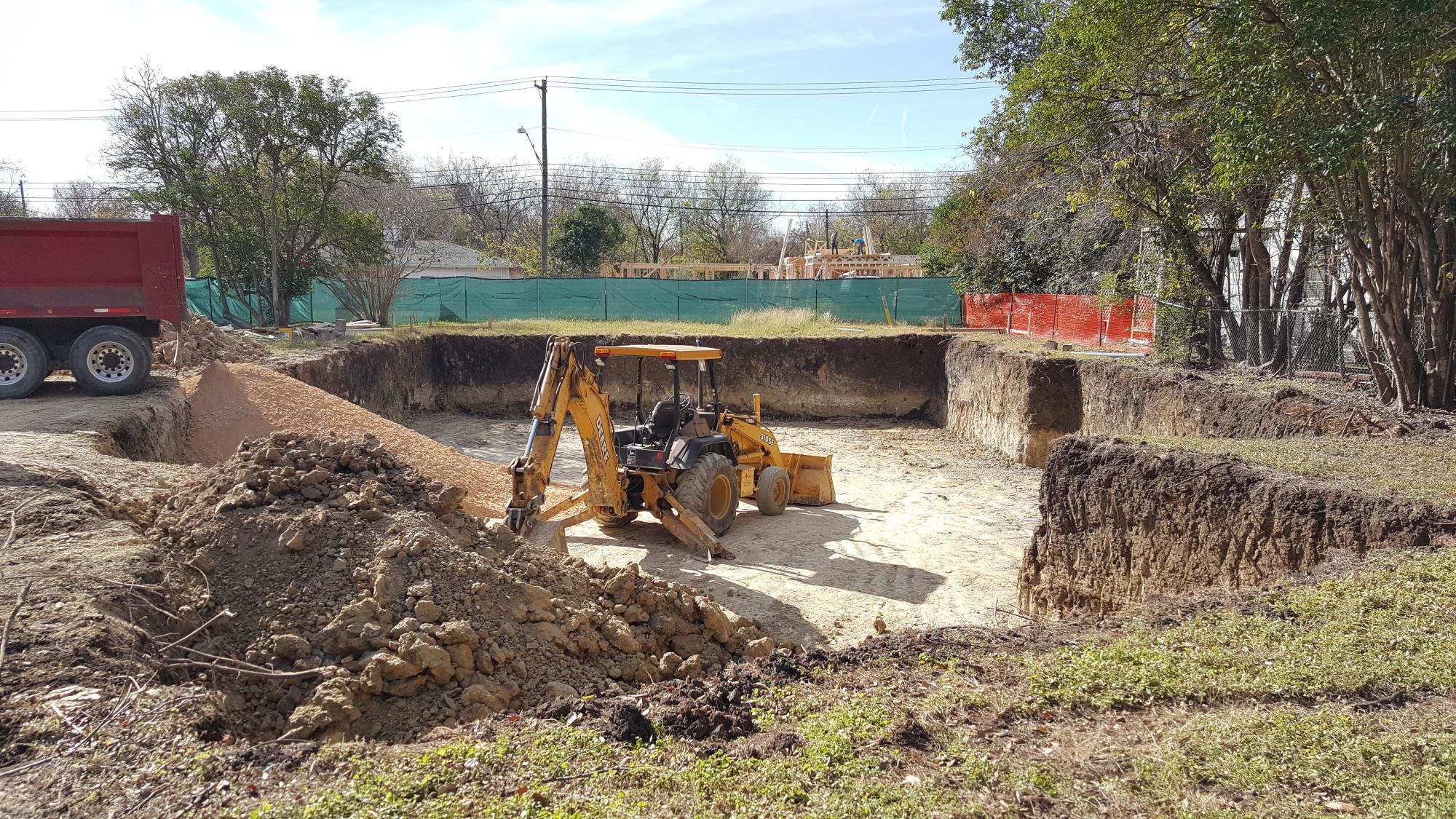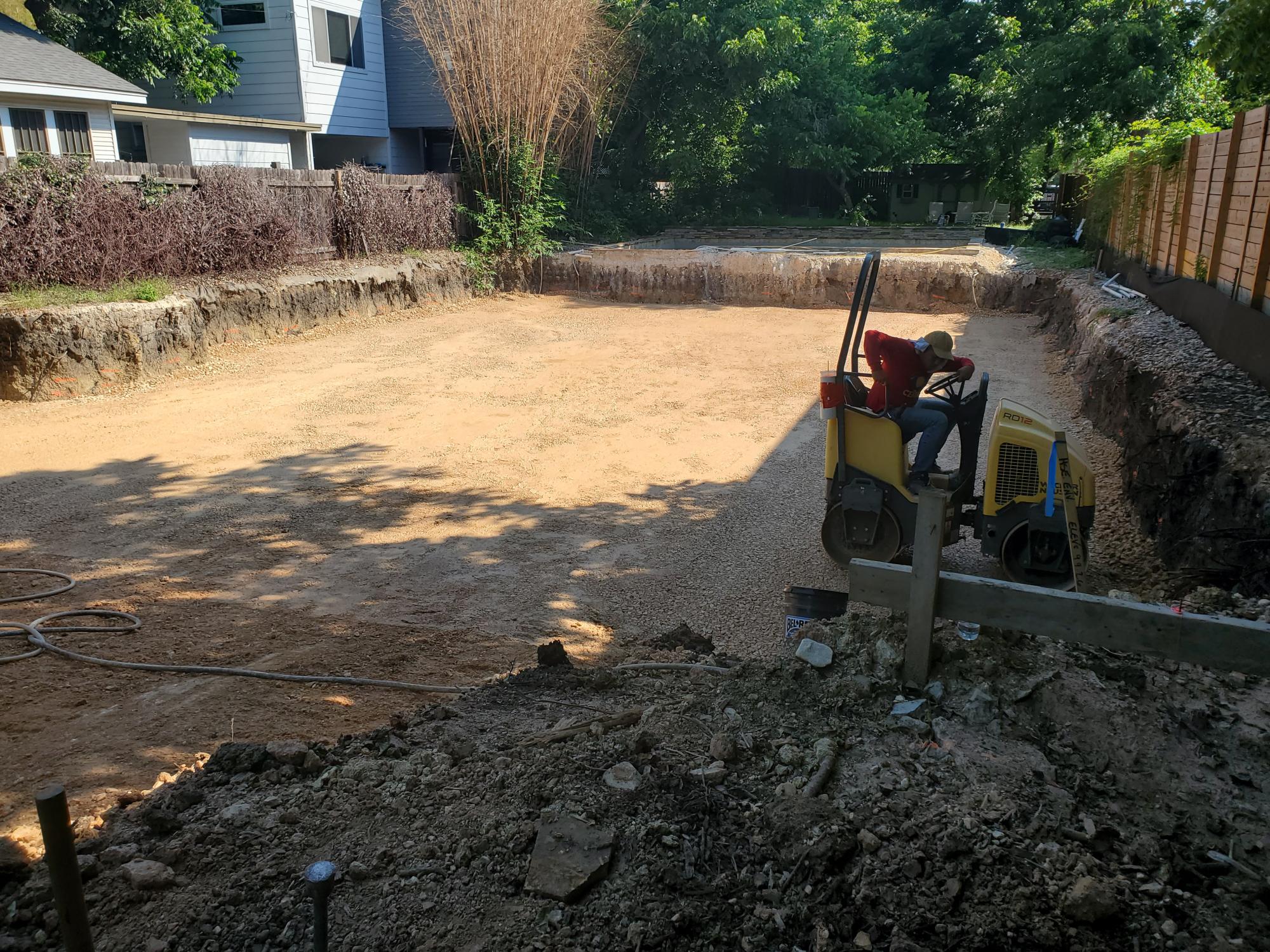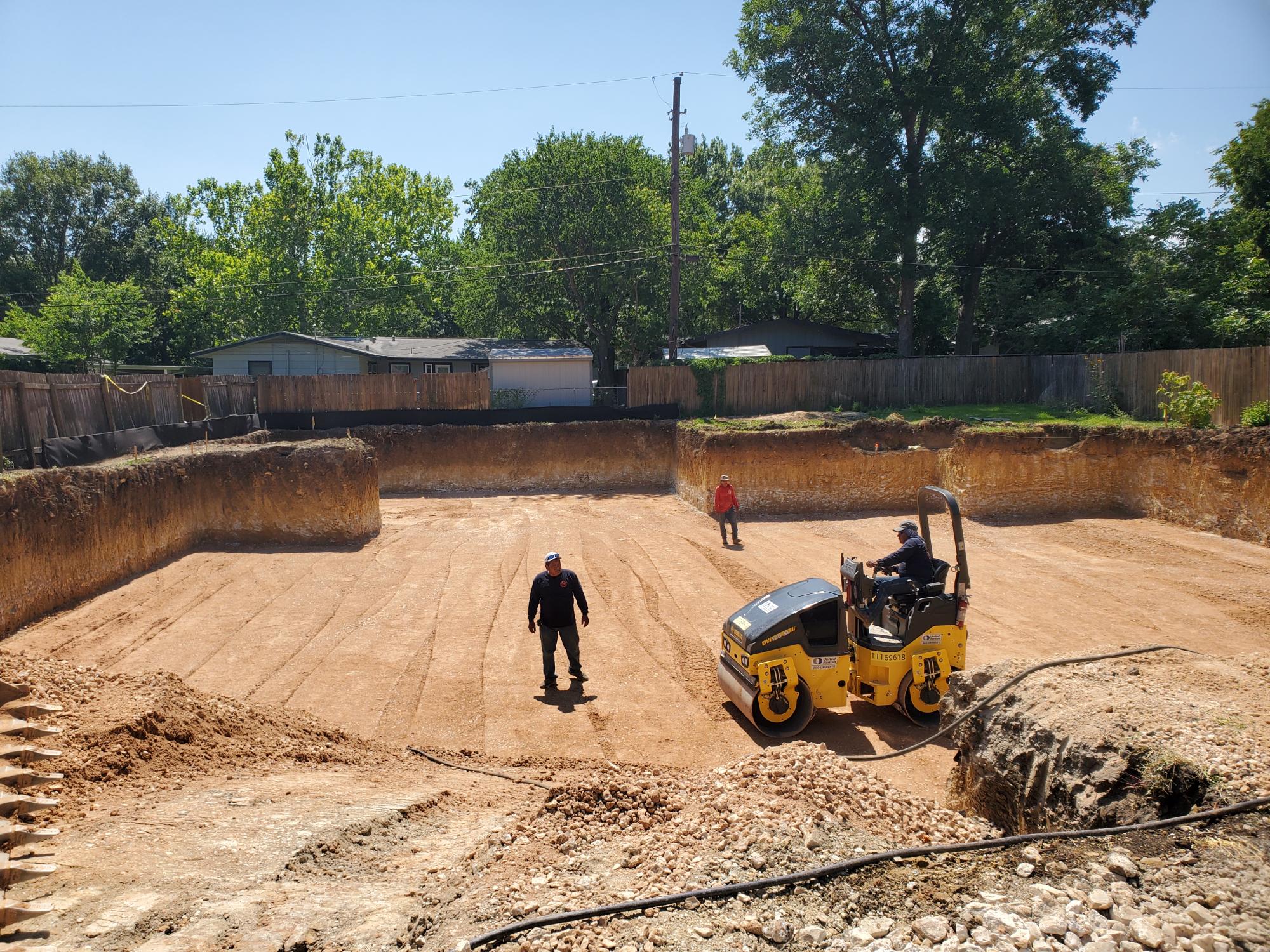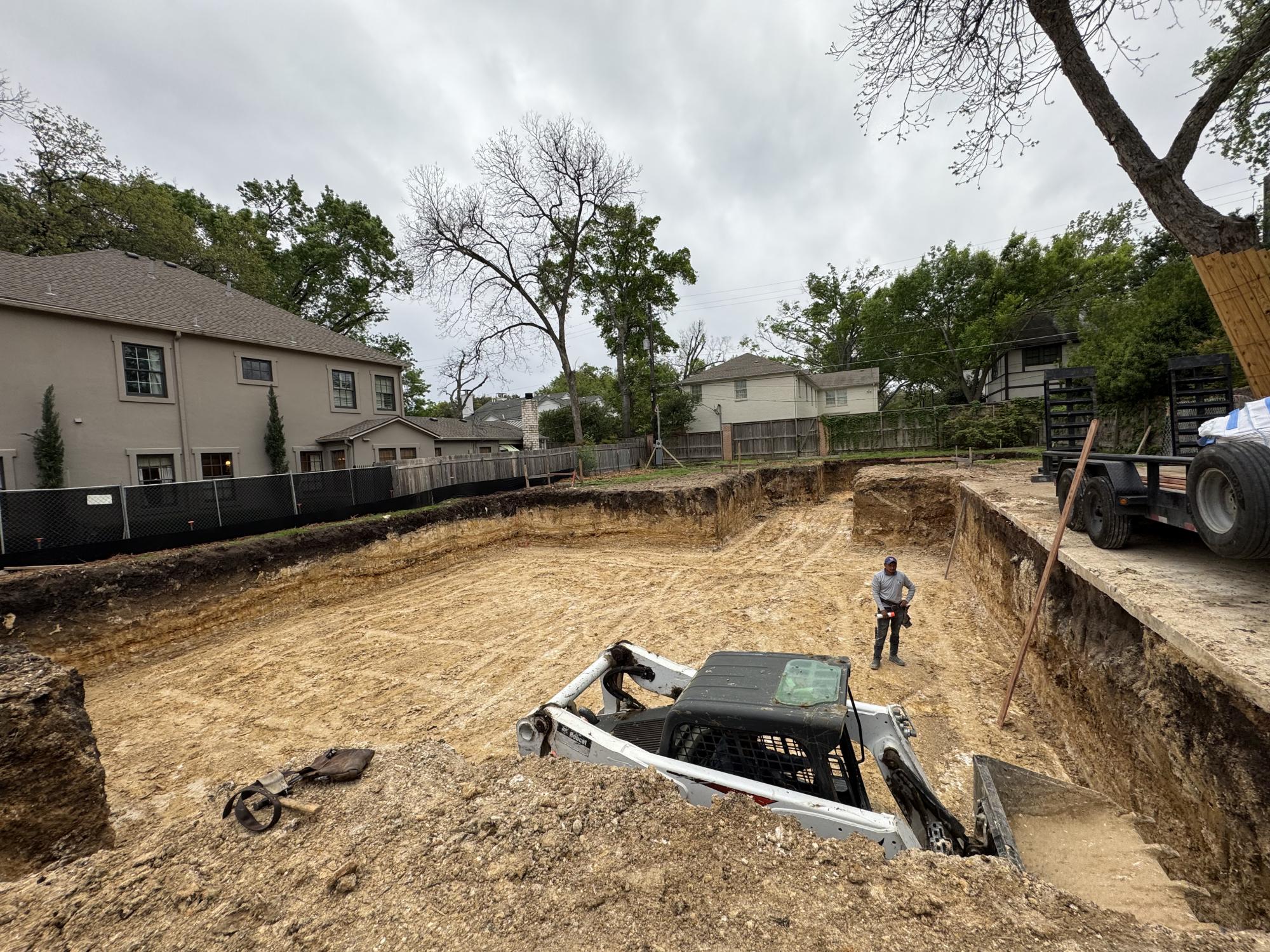One recommendation we make repeatedly for house and multi-family structures constructed on expansive clay is to use full-height crack control joints in any exterior brittle veneer such as stone masonry, brick, stucco, etc. Here is a picture of a vertical crack control joint doing half of its job. Unfortunately, the right side is exhibiting severe distress. The freedom of movement permitted by the joint could not stop the cracking since the magnitude of movement was too large, but the joint prevented the distress from propagating to the left.
Here is another house slab that exhibited differential vertical movement, causing all manner of interior cosmetic cracking, but the exterior brick veneer was spared by the presence of full height joints. The joint itself opened 1 inch wider at the top, but prevented the brick from cracking except at the very bottom left. The joint filler fell apart and the aesthetics are not pleasing, but it is much better than horribly cracked brick veneer 15 feet in both directions. Note that the perimeter beam cracked.
Mitigating Effects of Clay Soil Movement
Soil Improvement:
The ideal mitigation method is to perform soil improvement. Below are some examples of projects where soil improvement was performed to reduce the design PVR to a level acceptable to the Owner, Architect, Structural Engineer, and Builder, hopefully congruenlty. Note that Capital Geotechnical Services provided the geotechnical engineering services for all but two of the projects presented below.
An effective way to reduce the risk of differential soil and foundaton slab movement is to perform soil improvement. A mitigation effort Mr. Kauffman has been promoting for over 20 years. This custom home site in Cedar Park included removal of 18 inches of dark expansive clay and replacing it with compacted granular select fill (crushed limestone). The thickness of the native clay varied from 2 to 3 feet and was underlain by limestone rock. The improvement reduced the design PVR to an acceptable level.
This commercial expansion site near the old Northcross Mall in Austin was improved in 2013 by under-cutting the 2 feet of dark expansive clay surface stratum soil and replacing it wiht properly compacted select fill (in this case a crushed recycled concrete product). The exposed subgrade consisted of limestone chalk formation materials.
This house footprint on an urban lot in south-central Austin was improved by under-cutting 4 feet of expansive clay and replacing it with properly compacted select fill. The fill was placed before the perimeter formwork so the pad extended 3 feet beyond the slab footprint. This also permitted the use of shallow perimeter beams.
Another form of soil improvement is water and chemical pressure injection. This method involves pre-swelling the clay and possibly modifying the physical and chemical properties of the clay depending on the type of chemical used by hydraulically pushing injection rods deep into the clay. A new warehouse site in San Marcos in 2015 was improved by performing 12 feet of injection before constructing a thick select fill cap in the building area and paving most of the site (impervious cover). The pavement areas were also injected but only to a depth of 6 feet.
This is a custom home site in Austin where 1 to 2 feet of old fill and surface expansive clay were removed and replaced with properly compacted select fill.
This house footprint on an urban lot in south-central Austin was improved by under-cutting 4 feet of expansive clay and replacing it with properly compacted select fill. The fill was placed before the perimeter formwork so the pad extended 3 feet beyond the footprint. This also permitted the use of shallow perimeter grade beams.
This urban lot in west-central Austin on Pruett Street was improved in 2013 by excavating the 2-ft to 5-ft thick shallow clay and replacing it with properly compacted select fill to reduce the design PVR to a level acceptable to the Owner, Architect, Builder, and Structural Engineer. This is another urban renewal lot where the old house was demolished and replaced with a new home.
This single-family house urban lot in Austin on Ann Arbor Ave was improved by removing 4 feet of expansive clay and replacing it with crushed stone base select fill compacted in thin lifts.

The site preparation for this warehouse site in San Marcos included 5 feet of removal of clay and replacement with properly compacted select fill to reduce the design PVR to a level acceptable to the Owner (i.e. 2 inches).

This custom home site on Terrain Ln in Austin was improved by excavating 32 inches of clay and replacing it with properly compacted select fill.
This custom home site on Bridle Path was improved by removing 2 feet of clay and replacing it with properly compacted select fill.

The design and construction of this bank site in Round Rock included the removal of several feet of highly plastic clay and replacement with properly compacted select fill to reduce the design PVR to a level acceptable to the project team.
This custom home site on an urban lot in Austin on Rosedale Ave involved a 24-inch to 30-inch deep soil improvement excavation and replacement with compacted crushed stone select fill.
This custom home site on 45th Street in Austin included the removal of 2 feet of expansive clay and replacement with compacted select fill.

This house on East 50th Street in Austin in 2015 involved the removal of 8 feet of clay and replacement with properly compacted select fill. The house footprint was not a simple rectangle and required more tedious excavation efforts.
This custom home site in central Austin on Norwalk Ln included 4 feet of removal and replacement (2016).
This Capital Geotechnical Services project in northwest-central Austin on Evergreen Ct in 2017 involved a 7-ft deep soil improvement excavation for the main house and a 6-ft deep excavation for the detached garage.

This Capital Geotechnical Services project also on Evergreen Ct involved a 7-ft to 8-ft soil improvement excavation for a new custom home structure.


Capital Geotechnical Services was the Geotechnical Engineer of record for this townhouse and mixeduse development site in Leander on Hero Way. The project included soil improvement excavations of various depths (remove clay and old fill and replace with select fill) (2018 construction).
This new house site on Rosedale Ave was improved by using a removal and replacement soil improvement method.

This retail development in Manor on FM973 (2018) included 6 to 8 ft deep soil improvement excavations.

This duplex site on Sara Drive in Austin involved a 4-ft deep soil improvement excavation to remove expansive clay (2018).

This gas station and convenience/retail store site in Hutto involved a 4-ft deep soil improvement exavation in the building area (2019).
This detached guesthouse and detached office structure on an SF lot on Beverly Rd in Austin, Texas, involved 4 feet to 4.5 feet of soil improvement excavations under the 2 building slabs (2019).

This house site on Barrow Ave in Austin required a 3 to 4 ft deep excavation to remove expansive clay and reduce the design PVR to an acceptable level (2019).

This house site on West Frances Pl in Austin required a 3 ft deep excavation to remove expansive clay and reduce the design PVR to a level acceptable to the Owner, Architect, and Structural Engineer (2 inches) (2019). Capital Geotechnical Project # 19-0062.

This house site on Whispering Breeze Dr in Bee Cave included a 30-inch deep soil improvement excavation. Capital Geotechnical #21-0031.

This addition project in 2021 in Austin included a 4-ft deep soil improvement excavation. Capital Geotechnical #19-0177.
This house project on Hether St. in Austin, Texas, included a 5-ft deep soil improvement excavation. 20-0084cmt.


This addition project on Maufrais St. in Austin, Texas, included a 5-ft to 6-ft deep soil improvement excavation. 22-0047.

This custom home project in Austin on Fresco Drive involved an 8-ft deep soil improvement excavation and included improvement around the pool walls (Project #21-0129).

This custom home project in Austin on Preston Ave involved an 6-ft deep soil improvement excavation and included deep perimeter beams to avoid overbuild into CRZs and side setback areas (Project #24-0126).
